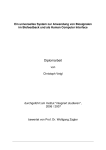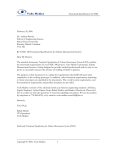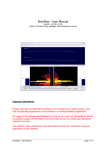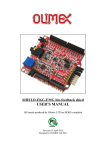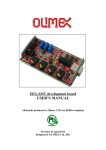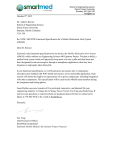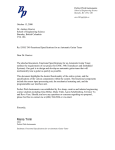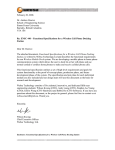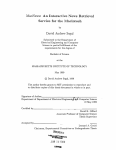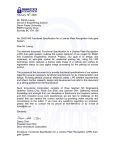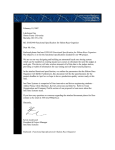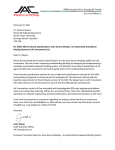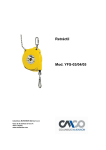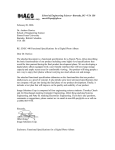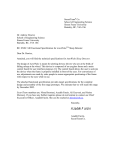Download Victor Yu - School of Engineering Science
Transcript
Brain Signal Operated Technologies [email protected] October 16, 2006 Dr. Andrew Rawicz School of Engineering Science Simon Fraser University Burnaby, British Columbia V5A 1S6 Re: ENSC 440 Functional Specification for Brain Signal Controlled Devices Dear Dr. Rawicz: The attached document, Functional Specification for Brain Signal Controlled Devices, lists the functional requirements for our proposed brain signal controlled devices. We are in the process of designing a computer game playable using brain wave signals. Originally, we planned to further enhance our technology after the development of the game by introducing a remote control car, whose movements can be directed by brain signals. However, after receiving advices from Professor Steve Whitmore and losing half of the team members due to other commitments, we have reorganized our goals, as evident in the classified functional requirements. This document details the functional and physical requirements that Brain Signal Controlled Devices will fulfill. We have stated what our products must deliver, should deliver, and wish to deliver given more time and labour. Brain Signal Operated Technologies is currently comprised of three enthusiastic engineering science students: Heng Wei Lan, Aron McKinnon, and Victor Yu. If you have any questions or concerns about our functional specification, please contact us at [email protected]. Sincerely, Victor Yu Victor Yu Chief Financial Officer BSO Technologies Enclosure: Functional Specification for Brain Signal Controlled Devices Functional Specification for Brain Signal Controlled Devices BRAIN SIGNAL OPERATED TECHNOLOGIES Project Team: Contact Person: Submitted to: Issued Date: Heng Wei Lan Aaron McKinnon Victor Yu Aaron McKinnon [email protected] Dr. Andrew Rawicz – ENSC 440 Steve Whitmore – ENSC 305 School of Engineering Science Simon Fraser University October 16, 2006 Brain Signal Operated Technologies Functional Specification for Brain Signal Controlled Devices Executive Summary Many brain controlled products in the market are not very user-friendly. Consumers often have to spend a vast amount of time and effort before becoming familiar and comfortable using the devices. To solve this problem, Brain Signal Operated Technologies (BSO Technologies) will develop a training system that will make learning to use a Brain Computer Interface (BCI) easy and entertaining. Our training system will allow users to use their biofeedback indicators in their brains to play the PONG game. The game not only encourages interactions between the two players (trainees), but also provides researchers with the progress of the training subjects. Our training device will be easy to set-up, requiring just the placement of an electrode cap on the trainee’s head. In order to attract end-users, our products shall meet various hardware, software, and safety conditions. We plan to complete our prototyping of the game by the end of 2006. Other additional features will be implemented in future developments. If time permits, we will start the production of a brain signal controllable toy. Copyright © 2006, BSO Technologies ii Brain Signal Operated Technologies Functional Specification for Brain Signal Controlled Devices Table of Contents Executive Summary ............................................................................................................ ii List of Figures ..................................................................................................................... v Glossary ............................................................................................................................. vi 1. Introduction................................................................................................................... 1 1.1 Scope................................................................................................................... 1 1.2 Intended Audience .............................................................................................. 1 1.3 Conventions ........................................................................................................ 1 2. System Overview .......................................................................................................... 2 3. System Specifications ................................................................................................... 3 3.1 General................................................................................................................ 3 3.2 Performance ........................................................................................................ 3 3.3 Safety .................................................................................................................. 4 4. Hardware Specifications ............................................................................................... 4 4.1 Physical Requirements........................................................................................ 4 4.2 Set-Up ................................................................................................................. 5 4.3 Features ............................................................................................................... 5 5. Software Specifications ................................................................................................ 6 5.1 General................................................................................................................ 6 5.2 Features ............................................................................................................... 6 5.3 Performance ........................................................................................................ 7 6. Documentation and Training Specifications................................................................. 7 6.1 Documentation.................................................................................................... 7 6.2 Training............................................................................................................... 8 7. Regulatory Specifications ............................................................................................. 8 7.1 Standards............................................................................................................. 8 8. Additional Specifications.............................................................................................. 8 8.1 General................................................................................................................ 8 8.2 Functions............................................................................................................. 9 9. Test Plan........................................................................................................................ 9 9.1 9.2 9.3 9.4 Electrodes............................................................................................................ 9 Electronic Circuits .............................................................................................. 9 PONG Game ....................................................................................................... 9 Entire System .................................................................................................... 10 Copyright © 2006, BSO Technologies iii Brain Signal Operated Technologies Functional Specification for Brain Signal Controlled Devices 10. Conclusion ...................................................................................................................11 11. References................................................................................................................... 12 Copyright © 2006, BSO Technologies iv Brain Signal Operated Technologies Functional Specification for Brain Signal Controlled Devices List of Figures Figure 2-1: PONG Training System Overview................................................................... 2 Copyright © 2006, BSO Technologies v Brain Signal Operated Technologies Functional Specification for Brain Signal Controlled Devices Glossary BCI BSO CMRR LabVIEW PC PCI PCB Brain Computer Interface Brain Signal Operated Common-Mode Rejection Ratio Laboratory Virtual Instrumentation Engineering Workbench Personal Computer Peripheral Component Interconnect Printed Circuit Board Copyright © 2006, BSO Technologies vi Brain Signal Operated Technologies 1. Functional Specification for Brain Signal Controlled Devices Introduction BSO Technologies is developing a BCI training system that is user-friendly, easy to set-up, and entertaining. As our first brain signal controlled device, the PONG Training System that will help physically disabled people adapt to BCIs easily. The device will feature two trainees communicating with the PONG software simply by thinking. The players will control the movements of the paddles in the game via their brain signals. The PONG Training System will serve as a basis for future BSO Technologies products. 1.1 Scope The document establishes the functional requirements of our PONG training device. We have provided a test plan for quality assurance. A separate section describing the functional specifications of our next product, the Remote Control Car, is also included. The research of this second innovation will start in late 2006 or early 2007. 1.2 Intended Audience The design engineers of BSO Technologies will use this document as a guideline in building the products. The project manager will use the document to ensure that the products possess the proposed functionalities. 1.3 Conventions The following notation is used throughout this document to describe each functional requirement: R[#P], where R stands for the word requirement, # indicates the requirement number, and P denotes the priority. H denotes high priority, M denotes medium priority, and L denotes low priority. By the end of 2006, the high priority requirements are MUST haves, the medium priority requirements are SHOULD haves, and the low priority requirements are MAY haves. Copyright © 2006, BSO Technologies 1 Brain Signal Operated Technologies 2. Functional Specification for Brain Signal Controlled Devices System Overview Our PONG Training System provides the interface allowing two players competing against each other by using their brain signals. The players will wear electrode caps, which will get connected to the computer containing the actual game, as illustrated in Figure 2-1. Signal Extraction Signal Conversion Headband Interface Box PONG Computer Figure 2-1: PONG Training System Overview The inputs of the system are the signals from the two players’ brain waves. These signals will first be extracted and interpreted by electrodes and other necessary hardware attached to the players’ caps. Then, the signals will be converted into useful information readable by our PONG software. Such conversion occurs in an interface box containing electronic circuitry. The status of the PONG game on the personal computer (PC) will be altered based on the understood signals (i.e. the players’ moves). Finally, the players will see the changes in the game and send new brain signals (i.e. their next moves). The details of each subsystem are not discussed for the purpose of this document. Copyright © 2006, BSO Technologies 2 Brain Signal Operated Technologies 3. Functional Specification for Brain Signal Controlled Devices System Specifications This section outlines the general system specifications of the PONG Training System. 3.1 General R[1H] The system must be able to operate at the normal customer temperature range from -20°C to 50°C. R[2H] The system must be able to operate under all domestic humidity and pressure ranges. R[3H] Operation of the system must be assisted by a physically healthy person (the operator). R[4H] Both physically healthy and physically disabled people must be able to use the system. R[5H] The system must be used by 2 players at the same time. R[6M] Users should be able to stop the system at any time. R[7L] The system may auto recover from any malfunctioning. R[8L] The system may report errors encountered, if any. 3.2 Performance R[9H] A player must not wait for more than 3 seconds to see the results of his/her intended moves. R[10M] The power supply of the system should last at least 1 day. R[11M] A single operation should continue for a minimum of 30 minutes before any restarting/adjusting is needed. For hardware-specific performance criteria, please refer to Section 4.3. Copyright © 2006, BSO Technologies 3 Brain Signal Operated Technologies Functional Specification for Brain Signal Controlled Devices 3.3 Safety R[12H] All users must not receive any discomfort from using the system, even in the case of the device malfunctioning. R[13H] The electrodes must not have any sharp edges that may injure a user’s head. R[14H] To avoid having loose wires from floating around and electronic components from hanging off edges of the device, all electronic circuitry must be mounted on Printed Circuit Boards (PCBs). 4. Hardware Specifications This section outlines the hardware specifications of the PONG Training System. As evident in Figure 2-1, the system has three main physical components: the electrode cap containing the electrodes, an interface box containing the majority of the electronic circuit designs, and a PC containing the PONG software. 4.1 Physical Requirements R[15H] Mass of all components (including the electrode cap, electrodes, and any necessary electronic circuits) attached on the players’ heads must not exceed 1 kg. The typical headbands and helmets weight approximately 0.5 kg [1],[2], too much weight or pressure placed on the head may cause neck injuries. R[16M] The electrode cap should be adjustable or supplied in different sizes to fit both children and adults. R[17H] All electronic components not associated with the cap must be enclosed in an interface box. R[18M] The interface box should neither exceed 20 cm in length nor 15 cm in width. R[19M] Any wires or methods of connection joining the cap and the interface box should be more than 1 meter in length. Enough length is necessary for easy adjustment of the electrode cap. Copyright © 2006, BSO Technologies 4 Brain Signal Operated Technologies Functional Specification for Brain Signal Controlled Devices 4.2 Set-Up The requirements in this section are critical to our PONG Training System because they offer an advantage over many commercial ones, which often require skin preparation and conductive paste for electrode placements [3]. Such procedures take extra time and make the users’ hair messy and sticky. R[20H] The entire set-up procedures must be easy and quick, requiring fewer than 5 minutes per user. R[21H] The attachments of the electrodes must not require any gel or paste. R[22H] Users must be able to connect to the system by placing the electrode caps on their heads. Each cap includes a pair of electrodes and an ear clip. 4.3 Features R[23H] The input signals from the brains must be amplified with a gain greater than 50,000 V/V. R[24H] The amplifier must strengthen the input signals to a maximum range of +10 V to -10 V. R[25H] The interface box must provide PCI bus compatibility in order to connect to the PC. To fulfill the low noise, high input impedance, and high common-mode rejection ratio requirements, our system should satisfy the next three specifications. R[26M] The input amplifier should experience an input voltage noise of 4 nV/√Hz at 1 kHz. R[27M] The input amplifier should experience an input impedance of 1 GΩ. R[28M] The input amplifier should experience a Common-Mode Rejection Ratio (CMRR) of 115 dB at 60 Hz. Copyright © 2006, BSO Technologies 5 Brain Signal Operated Technologies 5. Functional Specification for Brain Signal Controlled Devices Software Specifications This section outlines the software specifications of the PONG Training System. The PONG game will be created using the LabVIEW application. The game is played by two players against each other. Each player tries to move the ball passing the opponent’s paddle into the scoring zone. A player may direct the movements of the paddle vertically to defend his/her scoring zone. All the game options can be accessed by a hand-controlled mouse. Only the actual game play (the paddle movements) is controllable by the players’ brain signals. 5.1 General R[29H] The game must be able to run on a Pentium IV processor on Windows XP. R[30H] The game must be created using a software application called “Laboratory Virtual Instrumentation Engineering Workbench”, which is known as the LabVIEW. Hence, the client must install it ahead of time. R[31H] The game must be graphically based. 5.2 Features R[32H] Users must have an option to start the game. R[33M] Users should have an option to restart the game. R[34M] Users should have an option to pause the game. R[35H] Users must have an option to quit the game. R[36M] Users should have the ability to see the scores of the game. R[37H] Users must be able to control the up and down movements of their own paddles using their brains. Copyright © 2006, BSO Technologies 6 Brain Signal Operated Technologies Functional Specification for Brain Signal Controlled Devices 5.3 Performance R[38H] The paddles must move close or exactly to where the players wanted. Movements are acceptable as long as players do not visually notice the error. R[39M] The system should not experience any lag in the case where players attempt to move paddles in invalid directions or out of proper range. R[40H] The balls should be deflected at the speed and angle complying with the laws of physics. 6. Documentation and Training Specifications This section outlines the documentation and training specifications of the PONG Training System. We will provide a user manual describing any background knowledge needed before using the system, the steps to set-up the system, and a troubleshooting guide. In addition, a company website will be available, containing information for customers and potential investors. On-site training of the system will be provided to all users. Our technicians will ensure that the customers can set-up the system by themselves. Moreover, technicians will assist the users until they have a reasonably good control of the game play. 6.1 Documentation R[41H] A user manual in English must be provided, written in a way that non-technical users can understand. R[42L] User manual in other languages, such as Chinese, Japanese, and French, may be provided in order for the product to satisfy international markets. R[43H] Installation procedures must be available to users. R[44M] Troubleshooting and maintenance tips should be available to users. R[45H] A website must be set-up, providing the user manual and other technical information needed to use the system. R[46H] The company’s contact information must be included in all documents. Copyright © 2006, BSO Technologies 7 Brain Signal Operated Technologies R[47H] Functional Specification for Brain Signal Controlled Devices Warranty information must be available upon ordering of the system. 6.2 Training R[48H] On-site training must be available for all customers. R[49M] Additional training should be offered upon requests. R[50H] Technicians must provide system installation, troubleshooting, and system maintenance. R[51H] Technicians must assist users in adapting to the game environment. 7. Regulatory Specifications This section outlines the regulatory specifications of the PONG Training System. 7.1 Standards R[52H] The system must follow the standards specified in CAN/CSA-C22.2 NO. 60601-2-26-04: Particular Requirements for the Safety of Electroencephalographs [4]. R[53H] The system must follow the standards specified in IEC 60601-2-26: Particular Requirements for the Safety of Electroencephalographs [5]. 8. Additional Specifications This section outlines the specifications of the Remote Control Car. All specifications have low priority due to the fact that we may not start or complete the work. 8.1 General R[54L] The size of the car may be approximately 20 cm in length, 15 cm in width, and 10 cm in height. R[55L] Users may be able to control the movements of the car via their brain signals. Copyright © 2006, BSO Technologies 8 Brain Signal Operated Technologies R[56L] Functional Specification for Brain Signal Controlled Devices The weight of the car may be around 2 kg. 8.2 Functions R[57L] The car may be controlled within 10 meters from the user. R[58L] The car may move at a maximum speed of 20 cm/s. R[59L] The user may control up to four different movements of the car: forward, backward, left, and right. R[60L] The car may be able to move up an inclined slope of 30°. 9. Test Plan This section outlines the test plan of the PONG Training System. We will test each component individually to ensure proper operation before we conduct the system test. 9.1 Electrodes > We will test each electrode individually. > Once the above is completed, we will test a pair of electrodes simultaneously. > At last, we will test all electrodes together. 9.2 Electronic Circuits > We will make certain that the input signal is being amplified with the desired gain. > We will make sure the input amplifier have low noise, high input impedance, and high CMRR. 9.3 PONG Game > We will feed a signal to the PCI bus of the PC and see whether LabVIEW could receive the signal. Copyright © 2006, BSO Technologies 9 Brain Signal Operated Technologies Functional Specification for Brain Signal Controlled Devices > We will test that the PONG game can run on its own. > We will test each button and menu item of the software. 9.4 Entire System > We will connect two players to the PONG Training System. > We will verify that our system can correctly read each player’s brain signals. > We will verify that our game options work. > We will verify the game play undergoes correctly. > We will test the system using different users. Copyright © 2006, BSO Technologies 10 Brain Signal Operated Technologies Functional Specification for Brain Signal Controlled Devices 10. Conclusion The document clearly states the functional specifications that our brain signal controlled devices must deliver. We plan to finish the prototype of the PONG Training System by the end of 2006 and work on the Remote Control Car after that. We believe that by December 31, 2006, our PONG Training System will possess all the high-prioritized specifications, some, if not all, of the medium-prioritized specifications, and a few, if any, of the low-prioritized specifications. Copyright © 2006, BSO Technologies 11 Brain Signal Operated Technologies Functional Specification for Brain Signal Controlled Devices 11. References [1] Applied Fiberoptics Inc., “Orion Headlights,” 2003. [Online]. Available: http://www.appliedfiberoptics.com/orion.html [Accessed Oct. 10, 2006]. [2] REI-Outlet, “Giro G10 Helmet,” 2005. [Online]. Available: http://www.rei.com/outlet/product/48051318.htm [Accessed Oct. 10, 2006]. [3] OpenEEG, “OpenEEG Electrodes,” 2004. [Online]. Available: http://openeeg.sourceforge.net/doc/hw/electrodes [Accessed Oct. 13, 2006]. [4] Canadian Standards Association, “Electronic Catalogue,” 2006. [Online]. Available: http://www.csa.ca/electronic_catalogue [Accessed Oct. 13, 2006]. [5] International Electrotechnical Commission, “IEC 60601-2-26 - Ed. 2.0 - Bilingual,” 2006. [Online]. Available: http://webstore.iec.ch/webstore/webstore.nsf/artnum/031556 [Accessed Oct. 13, 2006]. Copyright © 2006, BSO Technologies 12



















